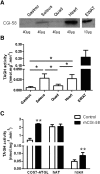Regulation of skeletal muscle lipolysis and oxidative metabolism by the co-lipase CGI-58
- PMID: 22383684
- PMCID: PMC3329383
- DOI: 10.1194/jlr.M019182
Regulation of skeletal muscle lipolysis and oxidative metabolism by the co-lipase CGI-58
Abstract
We investigated here the specific role of CGI-58 in the regulation of energy metabolism in skeletal muscle. We first examined CGI-58 protein expression in various muscle types in mice, and next modulated CGI-58 expression during overexpression and knockdown studies in human primary myotubes and evaluated the consequences on oxidative metabolism. We observed a preferential expression of CGI-58 in oxidative muscles in mice consistent with triacylglycerol hydrolase activity. We next showed by pulse-chase that CGI-58 overexpression increased by more than 2-fold the rate of triacylglycerol (TAG) hydrolysis, as well as TAG-derived fatty acid (FA) release and oxidation. Oppositely, CGI-58 silencing reduced TAG hydrolysis and TAG-derived FA release and oxidation (-77%, P < 0.001), whereas it increased glucose oxidation and glycogen synthesis. Interestingly, modulations of CGI-58 expression and FA release are reflected by changes in pyruvate dehydrogenase kinase 4 gene expression. This regulation involves the activation of the peroxisome proliferator activating receptor-δ (PPARδ) by lipolysis products. Altogether, these data reveal that CGI-58 plays a limiting role in the control of oxidative metabolism by modulating FA availability and the expression of PPARδ-target genes, and highlight an important metabolic function of CGI-58 in skeletal muscle.
Figures







Similar articles
-
Functional cardiac lipolysis in mice critically depends on comparative gene identification-58.J Biol Chem. 2013 Apr 5;288(14):9892-9904. doi: 10.1074/jbc.M112.420620. Epub 2013 Feb 14. J Biol Chem. 2013. PMID: 23413028 Free PMC article.
-
Muscle-specific deletion of comparative gene identification-58 (CGI-58) causes muscle steatosis but improves insulin sensitivity in male mice.Endocrinology. 2015 May;156(5):1648-58. doi: 10.1210/en.2014-1892. Epub 2015 Mar 9. Endocrinology. 2015. PMID: 25751639 Free PMC article.
-
Loss of perilipin 2 in cultured myotubes enhances lipolysis and redirects the metabolic energy balance from glucose oxidation towards fatty acid oxidation.J Lipid Res. 2017 Nov;58(11):2147-2161. doi: 10.1194/jlr.M079764. Epub 2017 Aug 19. J Lipid Res. 2017. PMID: 28822960 Free PMC article.
-
The Importance of Fatty Acids as Nutrients during Post-Exercise Recovery.Nutrients. 2020 Jan 21;12(2):280. doi: 10.3390/nu12020280. Nutrients. 2020. PMID: 31973165 Free PMC article. Review.
-
Critical roles for α/β hydrolase domain 5 (ABHD5)/comparative gene identification-58 (CGI-58) at the lipid droplet interface and beyond.Biochim Biophys Acta Mol Cell Biol Lipids. 2017 Oct;1862(10 Pt B):1233-1241. doi: 10.1016/j.bbalip.2017.07.016. Epub 2017 Aug 4. Biochim Biophys Acta Mol Cell Biol Lipids. 2017. PMID: 28827091 Free PMC article. Review.
Cited by
-
CGI-58: Versatile Regulator of Intracellular Lipid Droplet Homeostasis.Adv Exp Med Biol. 2020;1276:197-222. doi: 10.1007/978-981-15-6082-8_13. Adv Exp Med Biol. 2020. PMID: 32705602 Free PMC article. Review.
-
Characterization of lipolytic inhibitor G(0)/G(1) switch gene-2 protein (G0S2) expression in male Sprague-Dawley rat skeletal muscle compared to relative content of adipose triglyceride lipase (ATGL) and comparitive gene identification-58 (CGI-58).PLoS One. 2015 Mar 26;10(3):e0120136. doi: 10.1371/journal.pone.0120136. eCollection 2015. PLoS One. 2015. PMID: 25811590 Free PMC article.
-
The lipid droplet-associated protein ABHD5 protects the heart through proteolysis of HDAC4.Nat Metab. 2019 Nov;1(11):1157-1167. doi: 10.1038/s42255-019-0138-4. Epub 2019 Nov 15. Nat Metab. 2019. PMID: 31742248 Free PMC article.
-
Functional cardiac lipolysis in mice critically depends on comparative gene identification-58.J Biol Chem. 2013 Apr 5;288(14):9892-9904. doi: 10.1074/jbc.M112.420620. Epub 2013 Feb 14. J Biol Chem. 2013. PMID: 23413028 Free PMC article.
-
Growth and differentiation factor 15 is secreted by skeletal muscle during exercise and promotes lipolysis in humans.JCI Insight. 2020 Mar 26;5(6):e131870. doi: 10.1172/jci.insight.131870. JCI Insight. 2020. PMID: 32106110 Free PMC article. Clinical Trial.
References
-
- Haemmerle G., Lass A., Zimmermann R., Gorkiewicz G., Meyer C., Rozman J., Heldmaier G., Maier R., Theussl C., Eder S., et al. 2006. Defective lipolysis and altered energy metabolism in mice lacking adipose triglyceride lipase. Science. 312: 734–737 - PubMed
-
- Zimmermann R., Strauss J. G., Haemmerle G., Schoiswohl G., Birner-Gruenberger R., Riederer M., Lass A., Neuberger G., Eisenhaber F., Hermetter A., et al. 2004. Fat mobilization in adipose tissue is promoted by adipose triglyceride lipase. Science. 306: 1383–1386 - PubMed
-
- Lass A., Zimmermann R., Haemmerle G., Riederer M., Schoiswohl G., Schweiger M., Kienesberger P., Strauss J. G., Gorkiewicz G., Zechner R. 2006. Adipose triglyceride lipase-mediated lipolysis of cellular fat stores is activated by CGI-58 and defective in Chanarin-Dorfman Syndrome. Cell Metab. 3: 309–319 - PubMed
-
- Lefevre C., Jobard F., Caux F., Bouadjar B., Karaduman A., Heilig R., Lakhdar H., Wollenberg A., Verret J. L., Weissenbach J., et al. 2001. Mutations in CGI-58, the gene encoding a new protein of the esterase/lipase/thioesterase subfamily, in Chanarin-Dorfman syndrome. Am. J. Hum. Genet. 69: 1002–1012 - PMC - PubMed
Publication types
MeSH terms
Substances
Grants and funding
LinkOut - more resources
Full Text Sources
Other Literature Sources
Molecular Biology Databases

